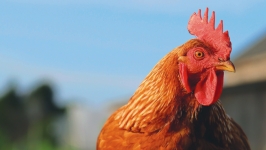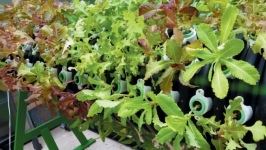Keep it Covered: Simple Solutions for Affecting Climate Change
As summer reaches full bloom, Connecticut farm stands and farmers markets teem with an array of local produce. Both producers and consumers of locally grown agricultural products have grown dramatically in recent years, and this shift is not limited solely to farms. Food gardening, too, has reached record levels. According to the National Gardening Association’s 2014 Special Report, food gardening has increased nationally by 43% since 2009.
This, of course, is good news for our climate. Shortening the food delivery chain via home gardens and local farms helps eliminate the fossil-fuel-driven transportation and distribution of food, which is a significant source of the carbon emissions that drive our warming climate.
And yet, despite this trend, bad news about the increasingly warm state of our planet continues to pour in. Currently, the atmosphere contains over 400 ppm (parts per million) of carbon dioxide, and the yearly ppm increases are accelerating.
According to 350.org, “many scientists, climate experts, and progressive national governments agree with Dr. Hansen [former NASA climate director and now Director of the Climate Science, Awareness, and Solutions Program at The Earth Institute at Columbia University] that 350 ppm is the ‘safe’ level for carbon dioxide. Any increase beyond this level will create thresholds that could have potent consequences.”
In his white paper entitled “Carbon Soil Restoration: Can Biology do the Job?” Jack Kittredge, Policy Director of the Northeast Organic Farming Association of Massachusetts (NOFA MASS), states “one part per million of carbon dioxide in the atmosphere contains 2.125 gigatons [Gt] of carbon. If that is the case, and we are at 400 ppm and need to get back to 350, we need to restore 50 ppm, or 106.25 Gt of carbon, to the soil. We know that all that carbon will fit in the soil, because that is where it came from. We have brought 136 Gt of carbon out of the soil by land clearing and agriculture since the beginning of the industrial age.”
The photosynthetic process – in which plants use sunlight to obtain food from carbon dioxide and water – pulls carbon dioxide from the atmosphere into the plant itself and, ultimately, deposits that carbon in the soil, preventing it from directly impacting the climate. This naturally occurring process is the primary driver of carbon sequestration, but agricultural and land management practices that expose that soil (such as plowing, tilling, and even mowing) rob it of its effectiveness and push that freshly captured carbon back into the atmosphere from which it was just removed.
“There is only one practical approach – to put [carbon] back where it belongs, in the soil,” Kittredge explains. “Fortunately, this is not an expensive process, but it will take large numbers of people agreeing to participate.
In this, there is an opening for each of us to make an impact. Consumers, homeowners, gardeners, and farmers can lead the way by maximizing the carbon dioxide pulled from the atmosphere and minimizing the loss once it is stored in the soil. Jeff Cordulack, Executive Director of the Connecticut Northeast Organic Farming Association (CT NOFA), agrees. “Since we measure soil carbon gains by the parts per million per square foot of land, land owners of all sizes can make a big impact on climate change. Each small gain adds up to gigatons of carbon dioxide removed from the atmosphere.”
Consumers & Homeowners
There are a number of steps that each of us can take to help reduce the impact of carbon in the atmosphere. Choosing organic – whether food or any other product – is a step in the right direction. Every organic purchase reduces the amount of synthetic fertilizers pumped into the ground. These fertilizers weaken the microbial diversity in the soil and reduce the soil’s ability to effectively retain carbon. Devotees of organic farming often exclaim that it is more than simply good for our bodies; it is also good for the planet, and a strengthening of the soil’s ability to retain carbon is just one of the ways in which that is true.
Homeowners can have additional impact on atmospheric carbon levels by altering the way in which they maintain their home. Abstaining from use of synthetic fertilizers strengthens the carbon sequestration occurring on gardens and lawns, and even raising the blade on the lawn mower can help during the growing season. According to the Federal Highway Administration, “if the mowing occurs during the growing season, grasses suddenly have significantly less leaf area for photosynthesis. In response, the plants divert the energy they capture into replacing leaf tissue instead of storing carbon in their roots. In some instances, grasses may even draw reserves from their roots to grow new leaves, thus decreasing the overall amount of plant carbon that could become organic matter. By raising the mower height to leave more leaf tissue, the rate of photosynthesis does not significantly decrease, and carbohydrates continue to be sent to the roots, which eventually leads to additional carbon sequestration.”
Gardeners & Farmers
For gardeners and farmers, using manures, mulches, and compost can help strengthen the soil and improve its ability to retain carbon. Once the growing season is completed, rather than stripping a garden or farm plot bare, Cordulack recommends covering the soil with these types of organic matter to feed it during the off season, all of which have longer-lasting benefits than the synthetic fertilizers for which they are often exchanged.
But of all the techniques that are available to protect soil, few are as effective, simple, and as uncommonly used as “cover cropping” practices. Cover crops are sown at the end of a growing season to protect the soil during the time of year when it would otherwise be exposed to the elements. These crops, grown to maintain or build the soil’s organic (carbon-based) matter and to add nitrogen to it, are often called a “green manure.” According to the Sustainable Agriculture Research and Education website, “legumes and grasses (including cereals) are the most extensively used [cover crops], but there is increasing interest in brassicas (such as rape, mustard, and forage radish) and continued interest in others, such as buckwheat.”
Cover crops are most often used on farms, but Cordulack points out that, since cover crop seeds are readily available in most organic seed catalogs, home gardeners can also use them to enrich their garden plots and help them operate as off-season traps for carbon.
If you don’t add a cover crop, Cordulack offers another solution to keep the soil covered and prevent carbon from oxidizing into the atmosphere: “Let the garden go over winter,” he says. “Cover it with some mulch or leaves at the end of the year to expose as little of the bare earth as possible. Come spring, don’t till the plot. Simply dig holes to plant seeds or transplants. This will help to leave underground fungal networks intact, which act as an additional carbon trap.”
This type of “no-till” garden disturbs the soil as little as possible and, as such, reduces the carbon emitted, because more soil remains covered. “The point is not to abandon tilling entirely,” Cordulack says, “but to think about what your tilling is going to accomplish and do as little tilling as possible.”
According to Kittredge, “the most important single lesson is that bare soil oxidizes carbon, while plants protect it.” Kittredge states that, if every farmer and gardener on the planet were to use carbon-building practices such as these, climate change could be reversed in five years.
While such a hope seems improbable, even small and individual actions can have a powerful cumulative effect. “It all adds up to gigatons of stored carbon,” Cordulack says.
“It’s not too late,” Cordulack maintains. “Before we understood the nature of climate change, there was little we could do to mitigate it. But now, we’re aware of one of its root causes, and in the next 10-20 years, all farms can be organic. We can not only halt but even reverse a great deal of carbon emission and, with it, the rising global average temperature, all through simple alterations to how we produce food.”
For more information about the topics and sources covered in this article, readers may reference the UConn, CT NOFA, and NOFA MASS websites.










